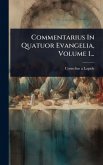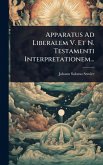Commentarius In Quatuor S. Evangelia Domini N. Iesu Christi... is a scholarly commentary on the four Gospels of the New Testament, written in Latin by Joseph Knabenbauer. This comprehensive work offers detailed analyses and interpretations of the Gospels, providing valuable insights into the historical, theological, and literary aspects of the sacred texts. Knabenbauerâ(TM)s commentary delves into the nuances of the original Latin, making it an essential resource for theologians, biblical scholars, and students of Christian history. This edition preserves the original text, allowing readers to engage directly with Knabenbauer's profound understanding of the Gospels and their enduring significance. This work has been selected by scholars as being culturally important, and is part of the knowledge base of civilization as we know it. This work was reproduced from the original artifact, and remains as true to the original work as possible. Therefore, you will see the original copyright references, library stamps (as most of these works have been housed in our most important libraries around the world), and other notations in the work. This work is in the public domain in the United States of America, and possibly other nations. Within the United States, you may freely copy and distribute this work, as no entity (individual or corporate) has a copyright on the body of the work. As a reproduction of a historical artifact, this work may contain missing or blurred pages, poor pictures, errant marks, etc. Scholars believe, and we concur, that this work is important enough to be preserved, reproduced, and made generally available to the public. We appreciate your support of the preservation process, and thank you for being an important part of keeping this knowledge alive and relevant.
Bitte wählen Sie Ihr Anliegen aus.
Rechnungen
Retourenschein anfordern
Bestellstatus
Storno








